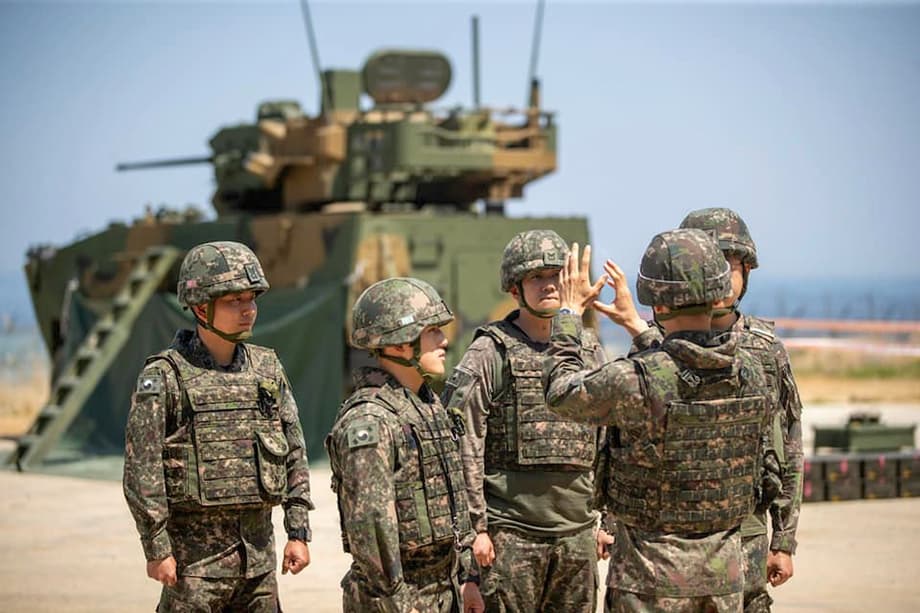Why this matters now
South Korea is revisiting the language used by its armed forces. Rep. Hwang Hee, a member of the National Assembly Defense Committee from the Democratic Party of Korea, has urged the Ministry of National Defense to purge Japanese era terms that still appear in commands, paperwork, and barracks slang. Ministry documents list many expressions that trace back to the Imperial Japanese Army, tools of instruction that slipped into the culture of the Republic of Korea Armed Forces in the late 1940s. The proposal seeks to replace these with clear Korean alternatives, aligning military language with national standards and the values of a modern democracy.
- Why this matters now
- What words are at issue inside the barracks
- How the terms took root after 1945
- Reform plans and the role of language authorities
- Supporters say change modernizes the force
- Skeptics warn of confusion and cost
- What it means for ties with Japan and regional security
- Implementing change inside a conscript army
- Key Points
Examples include kara (fake), penki (camouflage or deception), shimai (end or dismissal), and kusari (rebuke), once common in the Japanese military and later adopted during the formation of South Korea’s forces. Official jargon also retains Japanese style Sino Korean terms, such as tenko (roll call), kuho (double time or fast march), kosan (senior personnel), and zampan (leftover food). These still surface in training grounds, mess halls, and administrative routines, even as the country has been independent for decades.
The National Institute of the Korean Language has recommended straightforward replacements. Tenko becomes a personnel check. Kuho becomes running. Kosan becomes senior soldier. Zampan becomes leftover rations. Hwang also pointed to the barracks vocabulary that new conscripts absorb quickly, from kalkari (the itchy inner lining in winter clothing) and tenbo (easy duty) to malnyeon (a soldier about to separate) and chamchi (a new recruit). Many of these expressions, especially those rooted in the colonial period, sit awkwardly beside the plain Korean now used across government.
Arguing that speech shapes culture, Hwang framed the issue as both a practical reform and a matter of dignity for those who serve.
Young men who complete their military service return to society, so the purification of military language directly connects to broader improvements in national language culture. The Ministry of National Defense must take steps to organize and eliminate Japanese-style terminology and slang within the military environment.
His appeal overlaps with a broader effort to modernize military culture and reduce inherited habits from older eras. The Ministry of National Defense has cataloged problematic terms and faces pressure from lawmakers and language authorities to act. The debate blends history, identity, training needs, and the daily experience of conscripts.
What words are at issue inside the barracks
The language under review spans three broad categories, field commands and drill terms, administrative and logistical language, and informal slang. Some were introduced by instructors trained before liberation. Others spread informally in the barracks. A number persist because they are short and familiar.
Barracks slang that reformers want to retire
Several expressions have become shorthand among sergeants and privates. Reformers argue that retiring them, or replacing them with standard Korean, would cut confusion for new recruits and remove colonial era residue.
- kara (fake), used to label counterfeit or improvised items
- penki (camouflage or deception), used in the sense of cosmetic cover
- shimai (end or dismissal), used to wrap up a task or drill
- kusari (rebuke), used for a sharp scolding
- kalkari (itchy inner lining of winter clothing), a cold weather gripe
- tenbo (easy duty), a light shift sometimes resented by peers
- malnyeon (soldier nearing discharge), shorthand for a senior conscript
- chamchi (new recruit), a nickname that can feel dismissive
Some of these words are Japanese in origin. Others are barracks slang that drifted away from formal usage. All contribute to a speech culture that can feel opaque to outsiders and needlessly rough to many conscripts.
Sino Korean compounds in official usage
A separate group of terms sits in official manuals and orders. These are Sino Korean words shaped by Japanese military usage in the early 20th century. They carry prestige in some settings, yet their meaning is not transparent to new soldiers.
- tenko (roll call), a daily personnel verification
- kuho (double time or fast march), a movement command
- kosan (senior personnel), a category for experienced staff
- zampan (leftover food), a mess hall term
Language authorities recommend plain Korean replacements. Commanders can test both versions during a transition period, for example calling a personnel check alongside tenko until the new term takes root.
How the terms took root after 1945
Korea lived under Japanese colonial rule from 1910 to 1945. The colonial administration pushed assimilation and restrained the use of Korean in public life. Many Koreans learned Japanese in schools, and military and police units used Japanese doctrine and vocabulary. The legacy endured in institutions and in the habits of officials trained under the empire.
After liberation in 1945 and the division of the peninsula, South Korea built a military while confronting existential threats. Some early instructors and police veterans had careers that began during the colonial years. Training materials and procedures drew from what was available before American doctrine and equipment became dominant. The Korean War then accelerated growth and left little time for language housekeeping.
Post war governments launched language purification campaigns in civilian life. The military, a closed and mission driven institution, changed more slowly. Terms that were short, punchy, and familiar often won out on parade grounds and in barracks even as official documents were revised.
Reform plans and the role of language authorities
The National Institute of the Korean Language has assembled lists of recommended replacements and urged all ministries to adopt standard Korean. The Ministry of National Defense can fold these into drill, training materials, and administrative forms. Units can pilot new phrasing during routine roll calls, inspections, and safety briefings.
A credible plan would map where each legacy term appears, in commands, signs, forms, databases, and instruction. Manuals and smart device apps can carry both the old and new terms for a fixed period. The Defense Ministry can set a deadline for full adoption and retire the legacy vocabulary from official use.
Officer schools and noncommissioned officer academies can update lesson plans and evaluate commanders on accurate use. Conscripts would hear one standard from their first day. A central index of approved terms, searchable on mobile devices, would help busy leaders check phrasing without guesswork.
Supporters say change modernizes the force
Advocates present the reform as a low cost way to update culture and sharpen communication. Clear, modern language reduces ambiguity and improves safety. It affirms respect for those who serve, many of whom complete conscription and quickly return to civilian life.
The move also aligns with ongoing military modernization, from joint exercises to digital tools. Language is part of that upgrade. Short commands in plain Korean can be easier for recruits and reservists, especially those unfamiliar with older jargon.
Skeptics warn of confusion and cost
Critics caution that abrupt change can create friction. Drill commands are muscle memory. Swapping a word in a marching cadence or in an emergency call might confuse units in the short term. Training calendars are tight, and instructors already juggle many updates each year.
There is also a cost to reprinting manuals, reprogramming software, and refacing signs. Some argue that words like double time, or their Korean equivalents, are already clear and that hunting every legacy term will bring diminishing returns. A phased approach with dual labeling and a long overlap would address most of these concerns.
What it means for ties with Japan and regional security
The language cleanup is an internal matter. It does not change South Korea’s security cooperation with Japan or the United States. Seoul and Tokyo hold joint drills and share intelligence as part of a broader effort to manage threats from North Korea and to keep sea lanes open.
Even as security ties deepen, history remains sensitive. Disputes over wartime memory, from the enshrinement of Koreans at Yasukuni to statues dedicated to victims of wartime sexual slavery, still animate civic groups and courts. Many South Koreans also view the Rising Sun flag as a painful symbol of occupation. These debates continue in parallel with pragmatic cooperation.
Political turnover in Seoul has not erased the tension between strategic needs and historical memory. The current administration has pledged pragmatic diplomacy with both Washington and Tokyo while maintaining a firm stance on North Korea. Retiring colonial era terminology in the armed forces fits within that balance, a domestic reform tied to dignity rather than a break with partners.
Implementing change inside a conscript army
South Korea drafts most young men for active duty. That gives reformers a clear path to generational change. New cohorts arrive every few weeks. If training starts with the new vocabulary on day one, the old terms will fade as the cohort rotates.
A step by step plan could look like this.
- Publish a Defense Ministry directive that lists legacy terms and approved replacements, with a timeline.
- Update drill scripts, checklists, and safety cards, and train drill instructors on the revised commands.
- Revise signage and digital forms in garrisons, ranges, warehouses, and mess halls, and add quick response codes that link to pronunciations.
- Run a three month overlap with dual phrasing in commands for complex drills, then retire the legacy words.
- Evaluate units during inspections, checking correct usage, and reward compliance during promotion boards.
- Provide a feedback channel for soldiers to report confusion or propose clearer wording.
Reserve forces will need attention as well. Refresher training can carry the new phrasing, and online modules can reach veterans before they report to a drill site. Emergency services, where muscle memory matters most, should rehearse the updated words until they are automatic.
Key Points
- A lawmaker on the National Assembly Defense Committee is pressing the Defense Ministry to remove Japanese era terms from South Korea’s military.
- Examples flagged include kara (fake), penki (camouflage or deception), shimai (end or dismissal), and kusari (rebuke), plus official terms like tenko (roll call) and kuho (double time).
- The National Institute of the Korean Language recommends plain Korean replacements such as personnel check, running, senior soldier, and leftover rations.
- Reformers link the change to dignity and clarity, arguing that speech shapes culture and safety inside the ranks.
- Critics warn about training friction and cost, urging phased adoption with dual labeling and long overlap periods.
- The effort is domestic and does not alter cooperation with Japan or the United States, even as historical issues remain sensitive.
- A practical rollout would map where terms appear, retrain instructors, update manuals and apps, and evaluate units on correct usage.
- Conscription offers a natural path to change, as new cohorts can learn the updated vocabulary from day one.




